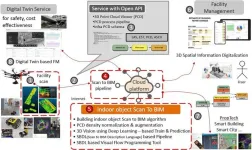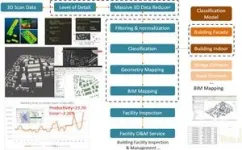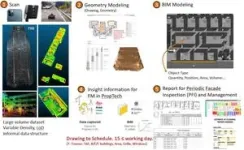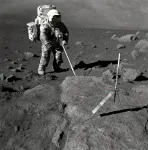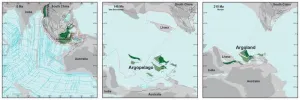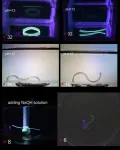(Press-News.org) Korea Institute of Civil Engineering and Building Technology (KICT, President Kim Byung-suk) has developed building scan to BIM (Building Information Modeling)-based reverse engineering technology required for 3D geospatial information modeling domains such as digital twin information modeling.
Scan to BIM-based reverse engineering technology was studied to prevent errors and rework caused by manual work when modeling shapes or BIM from 3D scan data. Existing reverse engineering work is either done based on a lot of manual work or semi-automatically using expensive overseas software.
KICT Research Fellow Dr. Kang Tae-wook and the international joint research team (University of North Florida, Prof Jonghoon Kim., Purdue University, Prof Kyubyung Kang., IUPUI, Prof Dan Koo., The State University of New York, Prof Jongseong Brad Choi) developed Scan to BIM technology customized for each reverse engineering purpose based on accumulated 3D vision, deep learning, and data processing pipeline technologies.
This technology automatically segments objects from 3D point cloud data, extracts shape information, and creates BIM objects. Through this, information model creation time and rework required for digital twins can be dramatically reduced. In this regard, productivity analysis cases were presented through SCIE paper (Kang, 2023, Scan to BIM Mapping Process Description for Building Representation in 3D GIS, Applied Sciences). According to published data, this technology improves reverse engineering productivity by 23.7 times and improves the amount of modeling information by 110.21%. Additionally, this technology can be customized depending on the purpose.
This technology is used for 3D precision map construction, 3D vectorizing, abnormal pattern detection during construction site safety management, precise construction management, and 3D digitalization of spatial information using the location, size, and direction information of objects required from scanned image data, etc. It can be used as a base technology that can be used in vision-based robotics and autonomous driving support systems.
The developed technology is being tested on-site with a scan reverse engineering company (BNG Co., Ltd) collaborating with Trimble Building Point in Korea and overseas partner organizations. In addition, for the development of the industry, some technologies were open-sourced and shared on GitHub (github.com/mac999/scan_to_bim_pipeline).
Dr. Kang said, "Currently, Scan to BIM reverse engineering automation technology is difficult to specialize for each purpose in construction, and the cost for the AEC (Architecture, Engineering, and Construction) industry to utilize the technology is also high." "The recently developed Scan to BIM technology will greatly help AEC domestic industrial competitiveness," he added.
###
The Korea Institute of Civil Engineering and Building Technology, a government-funded research institute with 40 years of extensive research experience, is at the forefront of solving national issues that are directly related to the quality of the people’s life.
This achievement is a research result related to the ‘3D vision & AI based Indoor object Scan to BIM pipeline for building facility management (2023)' project of the Korea Construction Research Institute's international research project.
END
KICT develops scan to BIM for reverse engineering from 3D vision data
Newly developed cost-effective technology
2023-10-23
ELSE PRESS RELEASES FROM THIS DATE:
Crystals brought back by astronauts show that the Moon is 40 million years older than scientists thought
2023-10-23
More than 4 billion years ago, when the Solar System was still young and the Earth was still growing, a giant object the size of Mars crashed into the Earth. The biggest piece that broke off of the early Earth formed our Moon. But precisely when this happened has remained a mystery. In a new study in the journal Geochemical Perspectives Letters, researchers used crystals brought back from the Moon by Apollo astronauts in 1972 to help pinpoint the time of the Moon’s formation. Their discovery pushes back the age of the Moon by 40 million years, to at least 4.46 billion years old.
“These ...
Probiotics delivered in biofilm state protect the intestines and brain in NEC model
2023-10-23
(COLUMBUS, Ohio) – Necrotizing enterocolitis (NEC) is a debilitating and deadly condition that affects infants who were born preterm. In NEC cases, intestinal tissues become inflamed, and in severe cases there is ischemia and death of the involved intestines. Treatment for NEC often involves surgery to remove the dying tissue.
“Even after decades of research, little has changed in terms of prognosis for infants who develop NEC,” says Gail Besner, MD, pediatric surgeon and principal investigator in the Center for Perinatal Research at Nationwide Children’s. ...
Heated yoga may reduce depression symptoms, according to recent clinical trial
2023-10-23
BOSTON – In a randomized controlled clinical trial of adults with moderate-to-severe depression, those who participated in heated yoga sessions experienced significantly greater reductions in depressive symptoms compared with a control group.
The results of the trial, which was led by investigators at Massachusetts General Hospital (MGH), a founding member of Mass General Brigham (MGB), and was published in the Journal of Clinical Psychiatry, indicate that heated yoga could be a viable treatment option for patients with depression.
In the eight-week trial, 80 participants ...
Finding Argoland: how a lost continent resurfaced
2023-10-23
Geologists have long known that around 155 million years ago, a 5000 km long piece of continent broke off western Australia and drifted away. They can see that by the ‘void’ it left behind: a basin hidden deep below the ocean known as the Argo Abyssal Plain. The underwater feature also lends its name to the newly formed continent: Argoland. The structure of the seafloor shows that this continent must have drifted off to the northwest, and must have ended up where the islands of Southeast Asia are located today. ...
Does diabetes affect the survival of individuals with colorectal cancer?
2023-10-23
Complications of diabetes can have numerous negative health effects, from impaired vision and nerve damage to kidney dysfunction and heart disease. In an analysis of information on adults with colorectal cancer, patients who also had diabetes—particularly those with diabetic complications—faced a higher risk of dying early. The results are published by Wiley online in CANCER, a peer-reviewed journal of the American Cancer Society.
For the study, Kuo‐Liong Chien, MD, PhD, of National Taiwan University, and his colleagues ...
Better regulation of mental health ‘therapies’ urgently needed to protect the vulnerable
2023-10-23
A rise in psychological pseudoscience is putting people at risk, psychologists have warned, with social media and celebrity endorsements partly to blame.
Mental health apps, mood-boosting supplements and energy therapies are among the therapies that could do ‘more harm than good’ according to psychologists Jonathan Stea and Stephen Hupp in their new book Investigating Clinical Psychology.
“As discourse around wellness, mental health, therapy, and access to these resources increasingly enter the public domain, the potential of coming across persuasive pseudoscience has also increased,” Stea explains.
“This is the age of health misinformation. It is everywhere. ...
Do people everywhere care less about their cats than their dogs?
2023-10-23
Do canines get more care? Some studies have suggested pet owners are less emotionally attached to and less willing to finance care for cats than dogs, possibly because of cats’ behavior: cats may be perceived as caring less about humans and needing less care in return. But these studies are often conducted on non-representative samples and don’t consider possible cultural differences in attitudes to pets. A team of scientists led by Dr Peter Sandøe of the University of Copenhagen decided to investigate further.
“We and others have found that people are willing to spend much less on their cats than ...
Association for Molecular Pathology appoints Lauren S. Menser as Chief Executive Officer
2023-10-23
ROCKVILLE, Md. – Oct. 23, 2023 – The Association for Molecular Pathology (AMP), the premier global molecular diagnostic professional society, today announced the appointment of Lauren S. Menser, CAE, as its Chief Executive Officer, effective January 3, 2024. Menser will succeed Mary Steele Williams, MNA, MT(ASCP)SM, CAE, after her retirement. AMP’s national search for a new executive leader was administered by an outside consulting firm and overseen by a diverse group of member volunteers.
Menser has served AMP in various capacities for more than 17 years. Since 2016, she has served as Director of Strategic Development, ...
Predictors of opioid overdose after prescription for chronic pain
2023-10-23
A large study published in CMAJ (Canadian Medical Association Journal) https://www.cmaj.ca/lookup/doi/10.1503/cmaj.230459 identified 10 predictors of opioid overdose after prescription for chronic pain, which can help clinicians engage in shared decision-making with patients around opioid prescribing.
“The opioid crisis has generated interest in identifying patients at higher risk of addiction or overdose and has led to the development of several screening tools; however, these instruments have either not been validated or shown poor psychometric properties,” writes Dr. Li Wang, a researcher and methodologist at the ...
Plant-based isn't just about burgers anymore
2023-10-23
A team of University of Waterloo researchers has created smart, advanced materials that will be the building blocks for a future generation of soft medical microrobots.
These tiny robots have the potential to conduct medical procedures, such as biopsy, and cell and tissue transport, in a minimally invasive fashion. They can move through confined and flooded environments, like the human body, and deliver delicate and light cargo, such as cells or tissues, to a target position.
The tiny soft robots are a maximum of one centimetre long and are bio-compatible and non-toxic. The robots are made of advanced hydrogel ...
LAST 30 PRESS RELEASES:
Air pollution exposure and birth weight
Obstructive sleep apnea risk and mental health conditions among older adults
How talking slows eye movements behind the wheel
The Ceramic Society of Japan’s Oxoate Ceramics Research Association launches new international book project
Heart-brain connection: international study reveals the role of the vagus nerve in keeping the heart young
Researchers identify Rb1 as a predictive biomarker for a new therapeutic strategy in some breast cancers
Survey reveals ethical gaps slowing AI adoption in pediatric surgery
Stimulant ADHD medications work differently than thought
AI overestimates how smart people are, according to HSE economists
HSE researchers create genome-wide map of quadruplexes
Scientists boost cell "powerhouses" to burn more calories
Automatic label checking: The missing step in making reliable medical AI
Low daily alcohol intake linked to 50% heightened mouth cancer risk in India
American Meteorological Society announces Rick Spinrad as 2026 President-Elect
Biomass-based carbon capture spotlighted in newly released global climate webinar recording
Illuminating invisible nano pollutants: advanced bioimaging tracks the full journey of emerging nanoscale contaminants in living systems
How does age affect recovery from spinal cord injury?
Novel AI tool offers prognosis for patients with head and neck cancer
Fathers’ microplastic exposure tied to their children’s metabolic problems
Research validates laboratory model for studying high-grade serous ovarian cancer
SIR 2026 delivers transformative breakthroughs in minimally invasive medicine to improve patient care
Stem Cell Reports most downloaded papers of 2025 highlight the breadth and impact of stem cell research
Oxford-led study estimates NHS spends around 3% of its primary and secondary care budget on the health impacts of heat and cold in England
A researcher’s long quest leads to a smart composite breakthrough
Urban wild bees act as “microbial sensors” of city health.
New study finds where you live affects recovery after a hip fracture
Forecasting the impact of fully automated vehicle adoption on US road traffic injuries
Alcohol-related hospitalizations from 2016 to 2022
Semaglutide and hospitalizations in patients with obesity and established cardiovascular disease
Researchers ‘listen in’ to embryo-mother interactions during implantation using a culture system replicating the womb lining
[Press-News.org] KICT develops scan to BIM for reverse engineering from 3D vision dataNewly developed cost-effective technology
